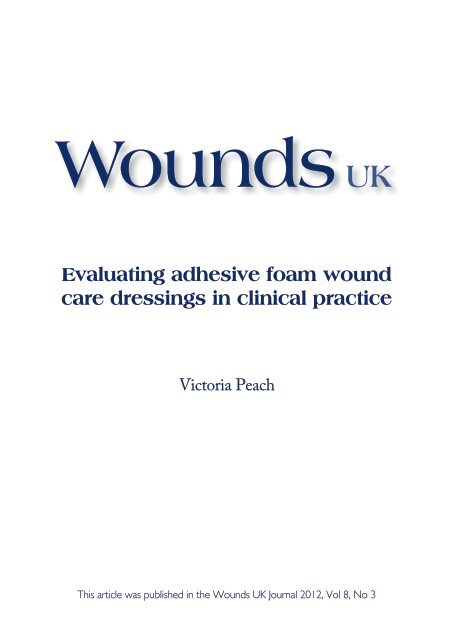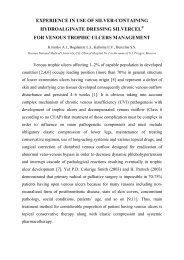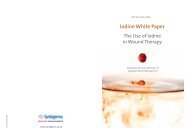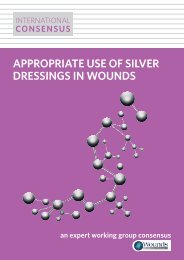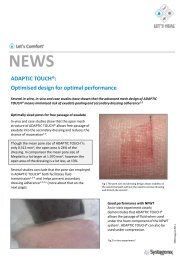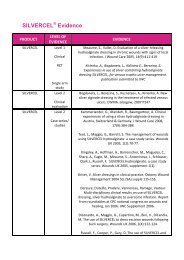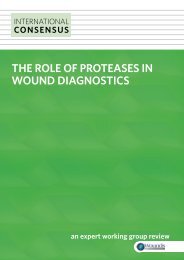Evaluating adhesive foam wound care dressings in ... - Systagenix
Evaluating adhesive foam wound care dressings in ... - Systagenix
Evaluating adhesive foam wound care dressings in ... - Systagenix
Create successful ePaper yourself
Turn your PDF publications into a flip-book with our unique Google optimized e-Paper software.
Wounds UK<strong>Evaluat<strong>in</strong>g</strong> <strong>adhesive</strong> <strong>foam</strong> <strong>wound</strong><strong>care</strong> <strong>dress<strong>in</strong>gs</strong> <strong>in</strong> cl<strong>in</strong>ical practiceVictoria PeachThis article was published <strong>in</strong> the Wounds UK Journal 2012, Vol 8, No 3
<strong>Evaluat<strong>in</strong>g</strong> <strong>adhesive</strong> <strong>foam</strong><strong>wound</strong> <strong>care</strong> <strong>dress<strong>in</strong>gs</strong> <strong>in</strong>cl<strong>in</strong>ical practiceAbstractBackground: Tissue viability nurses have an important role <strong>in</strong>ensur<strong>in</strong>g that product choice is cost effective and meets therequirements of the patient population, enabl<strong>in</strong>g quality <strong>care</strong> tobe provided. Identified as the most commonly used <strong>wound</strong> <strong>care</strong>product, <strong>foam</strong>s account for a significant proportion of health<strong>care</strong>expenditure (Bianchi et al, 2011). Aims: To evaluate <strong>foam</strong> <strong>adhesive</strong>products <strong>in</strong> practice. Method: A group of tissue viability nursesdeveloped an evaluation form specifically designed to capturethe performance of <strong>foam</strong> <strong>adhesive</strong> <strong>dress<strong>in</strong>gs</strong>. The performanceexpectations of <strong>adhesive</strong> <strong>foam</strong>s provided objectives for cl<strong>in</strong>icalevaluation, agreed as exudate management, conformability,adherence, ease of application, ease of removal and condition ofsurround<strong>in</strong>g sk<strong>in</strong>. This paper describes the evaluation process andcritiques the f<strong>in</strong>d<strong>in</strong>gs that enabled local decisions to be reached. The<strong>foam</strong> products chosen to be evaluated were pre-selected by cl<strong>in</strong>iciansvia a table-top evaluation. Results: The evaluation results have beenused to choose which <strong>foam</strong> <strong>adhesive</strong>s are on the local formulary. Theresults also identified that <strong>dress<strong>in</strong>gs</strong> were be<strong>in</strong>g changed on a rout<strong>in</strong>ebasis and education strategies were put <strong>in</strong> place to overcome this.Staff were <strong>in</strong>volved with the formulary decisions and are happy withthe outcome as well as the decisions reached.Cl<strong>in</strong>ical Research/AuditKEY WORDS Adhesive <strong>foam</strong> <strong>dress<strong>in</strong>gs</strong> Evaluation FormularyIn the current f<strong>in</strong>ancial climate, tissueviability nurses must demonstrate thatthey can use resources effectively, whilecont<strong>in</strong>u<strong>in</strong>g to provide quality <strong>care</strong> andevidence that product selection decisionsare based on the needs of the patientrather than the preference of the cl<strong>in</strong>ician(Department of Health [DH], 2010). Oneway that this can be achieved is by robustlyreview<strong>in</strong>g <strong>wound</strong> <strong>care</strong> product usage andupdat<strong>in</strong>g local <strong>wound</strong> <strong>care</strong> formularies.FoamsFoams are considered to be the mostcommonly used <strong>wound</strong> <strong>care</strong> dress<strong>in</strong>g(Bianchi et al, 2011), and evidence fromthe author’s area of practice <strong>in</strong>dicates thatthe <strong>foam</strong>s most often used are <strong>adhesive</strong>s.Anecdotal evidence identified that the<strong>foam</strong>s on the formulary <strong>in</strong> the author’sarea were not meet<strong>in</strong>g patients’ needs,for example, problems with sk<strong>in</strong> stripp<strong>in</strong>gand maceration were reported. While costis an important element of any formularyprocess, it is imperative that the cl<strong>in</strong>icalneeds of the patient are met. Only thencan cost-effectiveness be achieved.Foam products are versatile and can be usedas a primary or secondary dress<strong>in</strong>g. Bianchiet al (2011) concluded that no evidence iscurrently available that identifies one <strong>foam</strong>dress<strong>in</strong>g to be superior to another. Thiscomb<strong>in</strong>ed with the availability of such awide variety of <strong>foam</strong> <strong>adhesive</strong> productsand support<strong>in</strong>g company literature can beconfus<strong>in</strong>g for cl<strong>in</strong>icians, potentially lead<strong>in</strong>gto product choice be<strong>in</strong>g ritualistic or opento <strong>in</strong>dustry <strong>in</strong>fluence.As <strong>in</strong>dicated by Gray et al (2011), it isimperative that cl<strong>in</strong>icians are confidentthat the <strong>foam</strong> product they choose meetsthe needs of their patient population.VICTORIA PEACHTissue Viability Nurse Cl<strong>in</strong>ical Lead(Community), University Hospital of SouthManchesterWounds UK 2012, Vol 8, No 3 53
ReferencesBianchi J, Gray D, Timmons J, Meaume S(2011) Do all <strong>foam</strong> <strong>dress<strong>in</strong>gs</strong> have the sameefficacy <strong>in</strong> the treatment of chronic <strong>wound</strong>s?Wounds UK 7(1): 62–67DH (2010) Equity and Excellence: liberat<strong>in</strong>g theNHS. DH, LondonGray D, Cooper P, Russell F, Str<strong>in</strong>gfellow S(2011) 3M TM Tegaderm HP TM Foam Adhesivedress<strong>in</strong>g: a case report series. Wounds UK 7(3):60–66Payne WG, Posnett J, Alvarez O, et al (2009) Aprospective, randomised cl<strong>in</strong>ical trial to assessthe cost-effectiveness of a modern <strong>foam</strong> dress<strong>in</strong>gversus a traditional sal<strong>in</strong>e gauze dress<strong>in</strong>g<strong>in</strong> the treatment of Stage II pressure ulcers.Ostomy Wound Manage 55(2): 50–55Stephen-Haynes J, Bielby A, Searle R (2011)Putt<strong>in</strong>g patients first: reduc<strong>in</strong>g the human andeconomic costs of <strong>wound</strong>s. Wounds UK 7(3):47–5554 244 Wounds UK UK 2012, 2012, Vol Vol 8, 12, No No 3 12The studyAimsThis paper presents the process andresults of an evaluation of six <strong>adhesive</strong><strong>foam</strong> <strong>dress<strong>in</strong>gs</strong> <strong>in</strong> cl<strong>in</strong>ical practice. Foam<strong>adhesive</strong> products were reviewed bya group of cl<strong>in</strong>icians who consideredthe properties of the <strong>in</strong>dividual <strong>foam</strong><strong>dress<strong>in</strong>gs</strong> and selected the top sixproducts that they wished to take forwardfor cl<strong>in</strong>ical evaluation. The table topevaluation considered various aspects,such as packag<strong>in</strong>g, range of sizes andshapes, absorption, conformability andadherence.Study design and methodsA group of tissue viability nursesdeveloped an evaluation form specificallydesigned to capture the performanceof <strong>foam</strong> <strong>adhesive</strong> <strong>dress<strong>in</strong>gs</strong>. Theperformance expectations of <strong>adhesive</strong><strong>foam</strong>s provided the team with objectivesfor cl<strong>in</strong>ical evaluation. These were agreedto be: Exudate management Conformability Adherence Ease of application Ease of removal Condition of the surround<strong>in</strong>g sk<strong>in</strong>.Additionally, the reason why a dress<strong>in</strong>gchange was tak<strong>in</strong>g place; whether or notthe dress<strong>in</strong>g could be left <strong>in</strong> place longer;and any reasons for a dress<strong>in</strong>g be<strong>in</strong>gdiscont<strong>in</strong>ued, were also recorded.Due to the variance of <strong>wound</strong> types,differences <strong>in</strong> <strong>wound</strong> sizes, patient comorbidities,and differ<strong>in</strong>g reasons whya <strong>foam</strong> dress<strong>in</strong>g could be used, suchas palliation or heal<strong>in</strong>g, as well as timerestrictions, it was agreed not to useheal<strong>in</strong>g outcomes as a measure of success.Patient assessment and the criteria forselection of a <strong>wound</strong> dress<strong>in</strong>g was not tochange from standard practice. To thisend, nurses were asked to select only oneof the <strong>foam</strong> <strong>dress<strong>in</strong>gs</strong> be<strong>in</strong>g evaluated (seeDress<strong>in</strong>g Key above) after a <strong>foam</strong> dress<strong>in</strong>ghad already been identified as the <strong>wound</strong>product of choice.The aim was to discover the optimal <strong>foam</strong><strong>adhesive</strong> <strong>in</strong> l<strong>in</strong>e with current practice —this would <strong>in</strong>clude: Use as a secondary dress<strong>in</strong>g with avariety of other <strong>wound</strong> <strong>care</strong> productsDRESSING KEYFoam A — PermaFoam ® (Hartmann)Foam B — Tegaderm Foam Adhesive(3M )Foam C — Biata<strong>in</strong> ® (Coloplast)Foam D — Tielle ® (<strong>Systagenix</strong>)Foam E — Allevyn Adhesive(Smith & Nephew)Foam F — Tru<strong>foam</strong> Self-<strong>adhesive</strong>(Unomedical) Use on a variety of <strong>wound</strong> types andanatomical locations presented bypatients on a community nurs<strong>in</strong>gcaseload.Patients were selected over a six-weekperiod and nurses were requested toselect the most appropriate size and shapeof <strong>foam</strong> dress<strong>in</strong>g to correlate with the sizeand anatomical location of the <strong>wound</strong>be<strong>in</strong>g dressed.The nurses were asked to record sixconsecutive dress<strong>in</strong>g changes for eachpatient — if six consecutive dress<strong>in</strong>gchanges were not achieved, the reason forthis was to be recorded.Prior to commencement of theevaluation, each company representativewas <strong>in</strong>vited to attend a meet<strong>in</strong>g with amember from each nurs<strong>in</strong>g team. Theaim of the meet<strong>in</strong>g was to ensure thatcl<strong>in</strong>icians complet<strong>in</strong>g the evaluationwere familiar with the products andunderstood any specific <strong>in</strong>dividualproduct requirements, such as applicationor removal techniques.All nurs<strong>in</strong>g teams were also providedwith detailed written <strong>in</strong>structions of theevaluation process.It was decided that the evaluationshould not only <strong>in</strong>corporate cl<strong>in</strong>icaldata captured at dress<strong>in</strong>g changes, butshould also allow for nurses’ op<strong>in</strong>ionsand patients’ experiences to be taken <strong>in</strong>toaccount. Nurse preference forms andpatient experience forms were devisedfor this purpose. For nurses’ op<strong>in</strong>ions tobe regarded as valid it was important thateach had practical exposure to each ofthe six products. Therefore, each nurs<strong>in</strong>gteam evaluated all of the products.At the end of the evaluation period,
Cl<strong>in</strong>ical ReseaRch/audit‘All of the <strong>foam</strong>swere used totreat patientswith pressureulceration,leg ulceration,traumatic <strong>wound</strong>sand surgical<strong>wound</strong>s’688075 63117Foam AFoam BFoam CFoam DFoam EFoam FFigure 1: Proportion of changes for eachdress<strong>in</strong>g.nurses were sent a nurse preferenceform to complete. Patient experiencewas captured by complet<strong>in</strong>g a patientexperience form that asked simplequestions such as: Did you f<strong>in</strong>d your <strong>wound</strong> <strong>care</strong>dress<strong>in</strong>g comfortable? Did your dress<strong>in</strong>g stay <strong>in</strong> place? Did your dress<strong>in</strong>g leak?There was also a comments box for freeexpression.After collation of the evaluationforms, the results were discussed withrepresentatives from the participat<strong>in</strong>gnurs<strong>in</strong>g teams <strong>in</strong> order for a collectivedecision to be reached regard<strong>in</strong>g productformulary <strong>in</strong>clusion. A maximum of twoproducts were to be chosen to be listedon the formulary — two <strong>foam</strong> <strong>adhesive</strong>products provide cl<strong>in</strong>icians with sufficientchoice to ensure that patient needs arebe<strong>in</strong>g met; one <strong>foam</strong> may not be suitablefor all.86ResultsEighteen district nurs<strong>in</strong>g teams acrossthree geographical areas recorded a totalof 489 dress<strong>in</strong>g changes — these rangedfrom 63–117 per <strong>foam</strong> product (Figure1). Eighty-n<strong>in</strong>e percent of all dress<strong>in</strong>gchanges were completed as rout<strong>in</strong>epractice.A total of 34 evaluation forms, with apotential 204 dress<strong>in</strong>g changes, werediscarded due to <strong>in</strong>complete <strong>in</strong>formationor obvious mis<strong>in</strong>terpretation of theevaluation process. One recurr<strong>in</strong>gmis<strong>in</strong>terpretation related to entries<strong>in</strong>dicat<strong>in</strong>g that the size of the <strong>dress<strong>in</strong>gs</strong>elected was not suitable for the <strong>wound</strong>dimensions. The team had to reject theseforms as the use of too small or too largea dress<strong>in</strong>g has the potential to negativelyaffect the performance of these <strong>dress<strong>in</strong>gs</strong>.The types of <strong>wound</strong>s selected for each<strong>foam</strong> group were consistent, althoughthe number of <strong>wound</strong> types differed foreach group as did the number of dress<strong>in</strong>gchanges.All of the <strong>foam</strong>s were used to treat patientswith pressure ulceration, leg ulceration,traumatic <strong>wound</strong>s and surgical <strong>wound</strong>s(Figure 2). Other <strong>wound</strong>s <strong>in</strong>cludedfungat<strong>in</strong>g ulcers, diabetic foot ulcers,burns, and donor graft sites, the number ofwhich differed between <strong>foam</strong> groups.The location of the <strong>wound</strong>s for all <strong>foam</strong>groups was similar. One difference notedwas that Foam D was used for only threepatients present<strong>in</strong>g with lower limb/footulceration, whereas the other <strong>foam</strong>s ranged<strong>in</strong> number from 9 (Foam F) to 15 (Foam B).Pressure ulcerTraumatic <strong>wound</strong>Leg ulcerSurgical <strong>wound</strong>OtherFigure 2: Wound types assigned to each <strong>foam</strong>.56 Wounds UK 2012, Vol 8, No 3
Figure 3: Ease of application.All <strong>foam</strong> types were used both as aprimary and secondary dress<strong>in</strong>g withhydrogel sheets and ribbons, alg<strong>in</strong>ates,barrier creams and films, and povidoneiod<strong>in</strong>e commonly be<strong>in</strong>g used under the<strong>foam</strong> <strong>dress<strong>in</strong>gs</strong>. Foam A and E were notused <strong>in</strong> conjunction with silver alg<strong>in</strong>ates— all other <strong>foam</strong> groups were.Foam B, D, and E had comparative resultsfor ease of application, achiev<strong>in</strong>g over 55%for the ‘excellent’ and 30% for the ‘good’category (Figure 3). Five of the six <strong>foam</strong>groups achieved over 80% for comb<strong>in</strong>ed‘excellent’ and ‘good’ categories for easeof removal (Figure 4). There was m<strong>in</strong>imaldifference between <strong>foam</strong> A and B — bothgroups achiev<strong>in</strong>g ‘excellent’ for more thanhalf of <strong>dress<strong>in</strong>gs</strong> removals.The conformability of a <strong>foam</strong> dress<strong>in</strong>g canimprove patient comfort and thus have apositive impact on concordance. Althoughthere were some differences <strong>in</strong> how the<strong>foam</strong> <strong>dress<strong>in</strong>gs</strong> performed, there was littledifference between <strong>foam</strong> B and E, withboth achiev<strong>in</strong>g a 90% or greater score forthe way the pad and the <strong>adhesive</strong> edgecontoured to the <strong>wound</strong> and surround<strong>in</strong>gsk<strong>in</strong> (Figure 5). Foam D achieved a highpercentage of both pad and <strong>adhesive</strong>contour<strong>in</strong>g with no negative reportsthat neither the pad nor the <strong>adhesive</strong>contoured. Foam B was considered to bethe most adherent (Figure 6).A key function of <strong>foam</strong> <strong>dress<strong>in</strong>gs</strong> is theirability to manage exudate and reducenegative issues such as maceration.Foams A, B, D and E had comparablygood responses from cl<strong>in</strong>icians regard<strong>in</strong>gexudate management (Figure 7).Similarly, nurses record<strong>in</strong>g the condition ofthe surround<strong>in</strong>g sk<strong>in</strong> noted fewer problemswith issues such as maceration andredness <strong>in</strong> Foams A, B, and D. The levelsof discont<strong>in</strong>uation noted concurred withthese f<strong>in</strong>d<strong>in</strong>gs, with less frequent reports of<strong>dress<strong>in</strong>gs</strong> be<strong>in</strong>g withdrawn due to negativeoutcomes <strong>in</strong> <strong>foam</strong>s A, B and D, comparedwith the other <strong>foam</strong>s (Figure 8).Only Foam B was recorded as improv<strong>in</strong>gwear times (<strong>in</strong> over 50% of cases) withFoam D reach<strong>in</strong>g 40%. Foams A, C, andF were considered less likely to rema<strong>in</strong>‘A key function of<strong>foam</strong> <strong>dress<strong>in</strong>gs</strong>is their ability tomanage exudateand reducenegative issues,such as maceration’PoorAverageGoodExcellentFoamAFoamBFoamCFoamDFoamEFoamFFigure 4: Ease of removal.Wounds UK 2012, Vol 8, No 3 57
Cl<strong>in</strong>ical ReseaRch/audit‘The outcomecan be used todeterm<strong>in</strong>e the mostsuitable <strong>adhesive</strong><strong>foam</strong> productsused to serve thelocal population’FoamAFoamBFoamCFigure 5: Conformability of <strong>foam</strong>s.<strong>in</strong> place longer than the planned <strong>in</strong>tervalbetween dress<strong>in</strong>g changes (Figure 9).A total of 49 nurse preference forms werereturned. Of these, 24 were disregardeddue to nurses not confirm<strong>in</strong>g that theyhad experienced practical exposure to allof the <strong>foam</strong> <strong>dress<strong>in</strong>gs</strong> used <strong>in</strong> the study.Overall, Foams B, D and E were identifiedto be the <strong>foam</strong>s of choice.Comments on the nurse preference formsreflected those on the cl<strong>in</strong>ical evaluations.For example, comments on Foam B and D<strong>in</strong>cluded: ‘This dress<strong>in</strong>g appears much better <strong>in</strong>comparison with our usual dress<strong>in</strong>g’ ‘Good dress<strong>in</strong>g that rema<strong>in</strong>ed <strong>in</strong> placeand did the job’ ‘Adherence good; removal difficult’ ‘Patient and staff very impressed withthis dress<strong>in</strong>g’.Some <strong>foam</strong> <strong>dress<strong>in</strong>gs</strong> attracted morenegative comments such as: ‘A bit bulky’ ‘It wouldn’t stay <strong>in</strong> place’ ‘Initially good, then sk<strong>in</strong> reactionoccurred’FoamDFoamEFoamF ‘Not the best at stay<strong>in</strong>g <strong>in</strong> place yetdifficult to remove’.The comments on the patient experienceforms often related to pa<strong>in</strong> or comfortsuch as, ‘Wouldn’t use it aga<strong>in</strong> as notcomfortable,’ and, ‘Very happy withdress<strong>in</strong>g and nurse’.Often, the patient experience forms werecompleted by the nurse on the patientsbehalf, with comments such as, ‘Patientdid not like dress<strong>in</strong>g,’ or, ‘Patient found itpa<strong>in</strong>ful on removal.’discussioNThis evaluation aimed to capture dress<strong>in</strong>gperformance <strong>in</strong> <strong>wound</strong>s assessed byregistered nurses as suitable for treatmentwith <strong>adhesive</strong> <strong>foam</strong> products. However,each <strong>foam</strong> did not have an equal numberof allocated <strong>wound</strong> types or anatomicallocations, nor were the <strong>wound</strong>s of equaldimension or produc<strong>in</strong>g an equal amountof exudate. The commonality <strong>in</strong> this studywas that the suitability of the <strong>adhesive</strong><strong>foam</strong> dress<strong>in</strong>g, either as a primary orsecondary <strong>wound</strong> product, was assessedFoamAFoamBFoamCFoamDFoamEFoamFFigure 6: Adherence of <strong>foam</strong>s.58 Wounds UK 2012, Vol 8, No 3
FoamAFoamBFoamCFoamDFoamEFoamFFigure 7: Exudate management performance.by a registered nurse and that the patientwas on a community nurs<strong>in</strong>g caseload.The evaluation process replicated cl<strong>in</strong>icalpractice — therefore, the outcome canbe used to determ<strong>in</strong>e the most suitable<strong>adhesive</strong> <strong>foam</strong> products used to serve thelocal population.The most common reason fordress<strong>in</strong>g change was rout<strong>in</strong>e practice(for <strong>in</strong>stance, dress<strong>in</strong>g changeswere performed accord<strong>in</strong>g to a predeterm<strong>in</strong>edplan, three times a weekperhaps, rather than when exudatelevelsdictated), despite a largeproportion of reports at dress<strong>in</strong>g changeidentify<strong>in</strong>g that the dress<strong>in</strong>g could haverema<strong>in</strong>ed <strong>in</strong> place for a longer period oftime. Extra wear time can reduce overallcosts, particularly when manag<strong>in</strong>gchronic <strong>wound</strong>s, hence it should playa role <strong>in</strong> any decision regard<strong>in</strong>gformulary choice.Failure to maximise the benefitsof modern <strong>foam</strong> <strong>dress<strong>in</strong>gs</strong>, asdemonstrated by Payne et al (2009),could result <strong>in</strong> unnecessary cost, forexample, if a dress<strong>in</strong>g was changedmore often than cl<strong>in</strong>ically needed.If cl<strong>in</strong>icians do not maximise theuse of modern dress<strong>in</strong>g technologythere is also the potential for cl<strong>in</strong>icalconsiderations to be overridden byprocurement strategies based onpurchas<strong>in</strong>g cheaper <strong>dress<strong>in</strong>gs</strong>, whichmay not have the same patient benefits.Foam D was selected for use on fewerlower limbs than all other the <strong>foam</strong>s. Both<strong>foam</strong> D and F were chosen for use on asmaller proportion of pressure ulcers thanthe other four <strong>foam</strong>s. As each nurs<strong>in</strong>gteam were unaware of each other’s productselection this occurred by chance.However, this had m<strong>in</strong>imal relevanceto the overall f<strong>in</strong>d<strong>in</strong>gs as objectives formeasur<strong>in</strong>g success did not <strong>in</strong>clude heal<strong>in</strong>gand all parameters were based uponnurs<strong>in</strong>g assessment and judgment.Likewise, the categorisation of pressureulceration and chronicity of <strong>wound</strong>s wasnot recorded. Exudate management wassubjective accord<strong>in</strong>g to the assess<strong>in</strong>gnurses’ op<strong>in</strong>ion and all products wereopen to the same subjectivity.Nurse preference and free expression onthe cl<strong>in</strong>ical evaluation forms proved tobe valuable when qualify<strong>in</strong>g the f<strong>in</strong>d<strong>in</strong>gs.The comments enabled discussionpo<strong>in</strong>ts to be raised and enabled a greaterunderstand<strong>in</strong>g of the practicalitiesof us<strong>in</strong>g these <strong>dress<strong>in</strong>gs</strong>. This wasparticularly important due to the largeamount of nurse preference forms thatwere disregarded due to some nurses’lack of experience with all products.Patient experience forms did not produceany additional <strong>in</strong>formation, but <strong>in</strong>steadseemed to broadly support the f<strong>in</strong>d<strong>in</strong>gs ofthe other <strong>in</strong>formation-gather<strong>in</strong>g methods.The majority of the forms were completedby the nurse on behalf of the patient —this may account for the similarities <strong>in</strong> theresponses provided.To overcome this <strong>in</strong> the future, patientexperience could be assessed <strong>in</strong>‘The commentsenableddiscussionpo<strong>in</strong>ts to beraised andenabled a greaterunderstand<strong>in</strong>g ofthe practicalitiesof us<strong>in</strong>g these<strong>dress<strong>in</strong>gs</strong>’Wounds UK 2012, Vol 8, No 3 59
Cl<strong>in</strong>ical ReseaRch/auditFoamAFoamBFoamCFoamDFigure 8: Amount of <strong>foam</strong> <strong>dress<strong>in</strong>gs</strong> discont<strong>in</strong>ued.‘This evaluationenabled theperformanceof six <strong>adhesive</strong><strong>foam</strong> <strong>dress<strong>in</strong>gs</strong>to be comparedfor use with<strong>in</strong>a communitypopulation’FoamEFoamFFoam AFoam BFoam CFoam DFoam EFoam Fdifferent ways, for <strong>in</strong>stance, a telephonequestionnaire could result <strong>in</strong> differentf<strong>in</strong>d<strong>in</strong>gs.After the results were collated the groupof nurses <strong>in</strong>volved <strong>in</strong> the evaluation helda meet<strong>in</strong>g. The results were analysed anddiscussed, <strong>in</strong>clud<strong>in</strong>g comments made bynurses, patients or on the patients’ behalf.Follow<strong>in</strong>g this group discussion, <strong>foam</strong>sB, D and E were found to be the mostpopular products.A collective decision was reached for<strong>foam</strong> B and D to be <strong>in</strong>cluded on theformulary as both had fewer reports ofdiscont<strong>in</strong>uation (Figure 8).Additionally, <strong>foam</strong> B and D had uniquedifferences, particularly <strong>in</strong> relation to their<strong>adhesive</strong> actions, whereas <strong>foam</strong> B and Ewere similar.Includ<strong>in</strong>g two <strong>foam</strong>s on the formularyprovides choice for both the nurse andthe patient.coNcLusioNThis evaluation enabled the performanceof six <strong>adhesive</strong> <strong>foam</strong> <strong>dress<strong>in</strong>gs</strong> to becompared for use with<strong>in</strong> a communitypopulation. Nurse preference and patientexperience supported the cl<strong>in</strong>ical f<strong>in</strong>d<strong>in</strong>gsand a collective decision was reachedabout which of the <strong>foam</strong>s to <strong>in</strong>clude <strong>in</strong> thelocal product formulary.For patients with <strong>wound</strong>s, product choiceis only one element of their journey, withthe provision of high-quality <strong>care</strong> be<strong>in</strong>gdependent upon a number of other factors,such as the use of concise decision-mak<strong>in</strong>gtools, correct product usage, educated andappropriately tra<strong>in</strong>ed cl<strong>in</strong>icians, effectivemeasur<strong>in</strong>g and monitor<strong>in</strong>g of <strong>wound</strong> <strong>care</strong>systems, and a collaborative approachbetween public, health <strong>care</strong> and <strong>in</strong>dustry(Stephen-Hayes et al, 2011).Develop<strong>in</strong>g a local formulary based uponevidence that the needs of the patientpopulation are be<strong>in</strong>g met and ensur<strong>in</strong>gthat collective decisions are reached hasassisted with achiev<strong>in</strong>g the above factors.F<strong>in</strong>d<strong>in</strong>gs from this evaluation have <strong>in</strong>formededucation and tra<strong>in</strong><strong>in</strong>g strategies, ensur<strong>in</strong>gthat nurses have <strong>in</strong>creased their knowledgeof formulary products, that decision toolsare designed with reference to the specificbenefits of particular products, and thatcollaboration with companies can identifyhow to maximise wear time and ensure thatproducts are used effectively.It is important that formulary selection isreviewed on a regular basis to ensure thatlocal patients reap the benefits, especiallyas products are upgraded and newproducts become available. WUKNoneOne dayOver one dayFoamAFoamBFoamCFoamDFoamEFoamFFigure 9: Extra day wear time.244 60 Wounds UK UK 2012, Vol Vol 8, 12, No No 3 12


